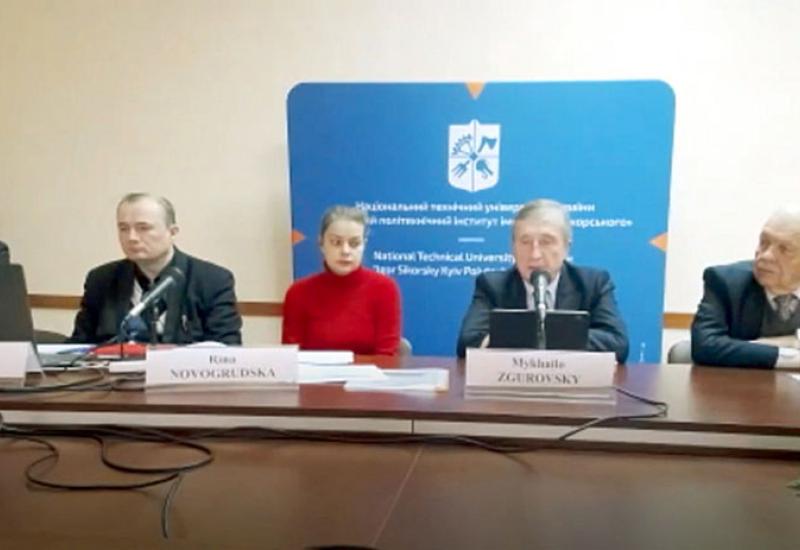On November 13-16, 2023, the traditional VI International IEEE Conference on Information and Telecommunication Technologies and Electronics UkrMiCo-2023 was held on the basis of Igor Sikorsky Kyiv Polytechnic Institute on the initiative and with the active participation of the Institute of ITS.
On the opening day of the conference, the participants were greeted by well-known domestic and foreign scientists. Rector of Igor Sikorsky Kyiv Polytechnic Institute, academician of the National Academy of Sciences of Ukraine Mykhailo Zgurovsky in his opening speech reminded that the UkrMiCo conference continues the traditions of the CriMiCo conference, which was held in Crimea before its occupation by the Russian aggressor, and noted that its holding contributes to the digital transformation of society. Professor Maksym Strikha, First Vice President of the Academy of Sciences of Higher Education of Ukraine, emphasized the particular importance of telecommunications research in times of war with the Russian invaders. He also expressed hope that the conference would be held in the Ukrainian Crimea again in the near future.
The honorary chairman of the conference, academician of the National Academy of Sciences of Ukraine, scientific director of the Institute of ITS, senior member of the IEEE Mykhailo Ilchenko also addressed the participants: "The VI IEEE UkrMiCo Conference informs the scientific community and society about the latest achievements in the field of information and communication technologies and radio electronics."
An important feature of the conference was that its topics are extremely relevant in terms of strengthening national security and defense, as this is a very important task for the entire scientific community today.
The organizing committee received 99 abstracts from potential conference participants from Ukraine, Sweden, the United Kingdom, Italy, Spain, Turkey, the Republic of Korea, Vietnam, Poland, and Latvia.
A large group of 42 experts reviewed the content of the submitted materials and prepared 270 reviews. The plenary session of the conference included 10 of the 30 highest-rated papers, and a total of 87 papers (80% of the total) were included in the conference program. They were divided into four sections: computer science - 12 papers; communications - 18 papers; microwave engineering - 23 papers; electronic devices - 17 papers; history - 17 papers.
On the first day of the conference, 10 reports were presented, among which it is especially worth noting the detailed information of S.A. Matvienko and S.S. Matvienko (SRL "Gravisat", Turin, Italy) "Radiophysical Relativistic Gravimeter". Its authors have developed an original radiophysical method for measuring gravitational field parameters in the radio frequency range using the relativistic redshift effect. Their stationary radiophysical relativistic gravimeter (RRG) has already been manufactured, tested and certified. It allows measuring the absolute value of gravity acceleration with an accuracy of 3-5 μG, as well as the change in gravitational potential at a height of less than 1 cm. Moreover, a modification of the differential radiophysical gravimeter has been developed, the measurement scheme of which eliminates the Doppler frequency shift when measuring from moving objects, including spacecraft (our newspaper reported in the previous issue on the conclusion of a memorandum between Igor Sikorsky Kyiv Polytechnic Institute, SRL "Gravisat" and Cinco on the joint development and implementation of the project to create the Gravisat space system).
There were also meetings in sections.
The Computer Science section presented 10 reports, including the most powerful research by Vitalii Dushepa and Ihor Baryshev (National Aerospace University "Kharkiv Aviation Institute") on "Neural Network Architectures for Assessing Image Registration Accuracy."
The Communications section consisted of 16 reports, divided into sub-sections Wireless Systems and Technologies, Signal Transmission and Processing in Telecommunication Systems, and Transmission Technologies in Telecommunications.
The section "Microwave Engineering, Antennas and Radars" included the subsections "Active and Passive Microwave Devices", "Positioning Technologies and Environmental Sensing Systems", "Development and Design Methods in Radio Engineering" with 25 reports. The best reports in this section, according to the chairman, were "Directional pattern of digital antenna array for satellite navigation" and "Preliminary design of the laboratory stand for remote and subsurface sensing of the Earth".
The section "Electronic Devices and Nanotechnologies" consisted of the sub-sections "Electronics in Astrophysics, Astronomy", "Vacuum and Discharge Technological Devices", "Microelectronics, Materials Science and Thin Films" with 15 reports. Particularly interesting was the report on the study "Strong photon-magnon coupling in a modified inverted ring resonator" by Oleksii Hirich, Serhii Nedukh, Serhii Polevyi, Artur Vakula, Kateryna Sova, Serhii Tarapov (Usikov Institute of Radio Physics and Electronics of the National Academy of Sciences of Ukraine, Gebze Technical University, Turkey).
The section "History of the Development of Information and Radio Technologies" consisted of 14 reports in the subsections "History of the Development of Information Technologies" and "History of the Development of Radio and Industrial Technologies". Most of the reports were prepared by researchers of the Dobrov Institute of Scientific and Technical Potential and History of Science of the National Academy of Sciences of Ukraine.
Following the conference, the papers included in the program and presented at the meetings will be submitted to the IEEE Xplore digital library, where they will be indexed in international scientific databases, including Scopus, Web of Science and Google Scholar.

